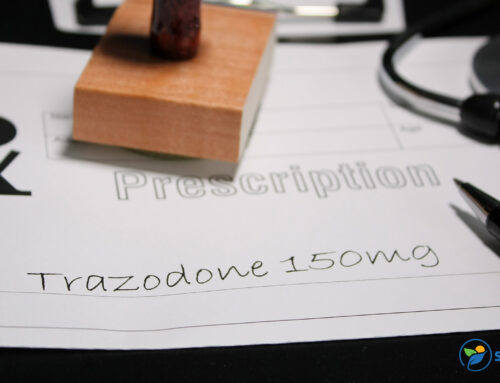If you or a loved one is going through depression, you’re not alone. According to the National Institute of Mental Health, approximately 21 million Americans in the United States experienced a major depressive episode in 2021. Characterized by persistent sadness, depression can negatively impact day-to-day life. Many people with depression struggle to fulfill responsibilities, engage in hobbies and maintain social relationships.
The good news is, these symptoms can be overcome with treatment. While treatments vary, most involve a combination of therapy and antidepressant medication. One of the most common medications is Celexa (citalopram), which improves symptoms by affecting your brain chemistry. Let’s take a closer look at what Celexa is, its side effects and how to manage them.
What Is Citalopram?
Celexa, the brand name for citalopram, belongs to a class of antidepressants called selective serotonin reuptake inhibitors (SSRIs). These drugs treat depression by increasing the levels of serotonin in your brain. Also known the “feel-good” chemical, serotonin assists with many bodily functions, including sleep, memory, digestion and mood.
Now that you know what this drug is, you may be wondering how long it takes for Celexa to work. Generally, people start to experience symptom relief within 1 to 2 weeks. However, it usually takes around 4 to 6 weeks for the drug to start working fully. Unless your doctor recommends otherwise, it’s usually best to wait 6 weeks before deciding whether the drug is effective.
Common Side Effects of Celexa
Although Celexa is known for its positive impact on mood, it’s also associated with several side effects. During the first few weeks, you may notice the following:
- Headaches
- Nausea
- Dry mouth
- Diarrhea
- Nervousness and restlessness
- Difficulty sleeping
- Increased sweating
While these side effects can be annoying, they’re usually not a cause for concern. Symptoms typically go away once your body gets used to the drug.
Rarer Side Effects of Celexa
In most situations, Celexa side effects are normal. However, in rare cases, a patient may experience an alarming or dangerous symptom. Here are some rare but serious side effects of Celexa:
- Low blood sodium levels (associated with weakness, memory problems and headaches)
- Teeth grinding
- Vision changes
- Swelling around the eyes
- Muscle tightness
- Fever
- Seizures
If you experience any of these symptoms, contact your medical provider immediately.
How to Manage Celexa Side Effects
When it comes to Celexa, every patient has their own unique experience. Some people may experience minimal, limited side effects, while others might experience a wide range of symptoms. If you’re dealing with those pesky but common effects, there are ways to help manage them. Here are a few tips to keep in mind:
- Monitor your side effects. Make sure you keep a close eye on your side effects and any changes you experience. If you start to notice any rare or serious side effects, contact your medical provider as soon as possible, as Celexa may not be the right medication for you.
- Address specific side effects. Plenty of medications can help relieve specific side effects. For example, if you have nausea, you can take over-the-counter medications or eat bland, simple foods. If you have insomnia, try to improve your sleep environment.
- Avoid alcohol. Substances such as alcohol are known to decrease the positive effects of antidepressants and encourage sedation. To ensure the drug is as effective as possible, it’s best to limit your alcohol use or even avoid it entirely.
- Practice a healthy lifestyle. Healthy lifestyle habits, such as maintaining a good diet, getting regular exercise and sleeping properly, can improve many common side effects. As an added benefit, they can even improve some depression symptoms.
- Stay connected. Dwelling on your side effects may make you feel worse. Maintaining relationships with friends, family and loved ones can improve your mood and help you stay distracted.
While there are plenty of ways to help manage the side effects of citalopram, you don’t have to navigate this journey alone. Your health care provider should serve as a supportive resource.
Seeking Medical Guidance
Once you’ve been prescribed Celexa, it’s important to keep your health care provider updated on your experience. Here are a few areas they can help with:
- Dosage changes. Depending on your side effects and mental health progress, your provider may recommend dosage changes. For example, if your side effects are debilitating, they may lower the dosage. On the other hand, if the drug isn’t effective enough, they may increase the dosage. In some cases, your provider might recommend switching to another medication altogether.
- Citalopram withdrawal symptoms. If you do stop using citalopram, you may experience withdrawal symptoms. These include but aren’t limited to irritability, dizziness, vomiting, nightmares and tingling skin. Your health care provider can help you prepare for withdrawal and — if necessary — recommend professional facilities where you can detox safely.
- Additional treatments. Although antidepressants can help reduce depression symptoms, they’re not a comprehensive solution. For the best results, medication is typically paired with psychotherapy sessions, during which patients work with professionals to understand the roots of their depression. Your provider can recommend therapeutic solutions and help ensure you’re receiving the most effective treatment possible.
No matter what you’re feeling or experiencing, it’s important to share it with your care team. The more they know about your health, the better your treatment will be.
Overcoming Depression and Achieving a Better Life
Overcoming depression can be a long, difficult journey. While antidepressants such as Celexa may help you manage mental health symptoms, they come with their own set of side effects. However, with the right health care team by your side, you can carefully manage those effects and achieve a healthy, safe treatment plan that works for you.
Are you looking for support as you navigate depression treatments? At Sunlight Recovery, we offer a wide range of mental health treatments, including therapy sessions for depression and medical support for withdrawal symptoms. Our goal is to make sure every patient receives the help they need while remaining as comfortable as possible. To learn more about how we can help you, contact our team today.






